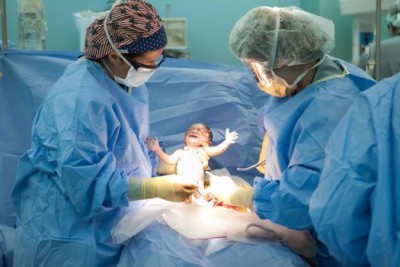Gentle Cesareans The Humane Future of Surgical Delivery
Main Article Content
Abstract
In 2013 nearly 1 in 3 American babies were born via cesarean delivery.[1] In the United States these deliveries are very clinical, with the primary concern being the medical safety and well-being of both mother and child. While this is a very important concern for surgeons (and patients), there is an often-overlooked interest in the emotional quality of a delivery. After an average of 39 weeks of gestation, the moment of birth is one of relief and excitement, yet women who undergo conventional C-sections can go hours without holding or seeing their newborn child.
In order to address this issue a growing trend of “family-centered cesareans”–also referred to as “gentle” or “natural” cesareans–has gained favor in Great Britain. The differences between family-centered C-sections and conventional C-sections is that mothers and fathers are given the option to watch the surgery and the delivery of their child, and in an additional effort to approximate a vaginal birth, as soon as the baby is delivered it is placed on the mother’s chest for skin-to-skin contact (which has been shown to provide a clinical benefit for newborns).[2],[3]
Over the past two years interest in gentle cesareans has increased in the United States, with stories about them featured on CBS and NPR’s Morning Edition.[4],[5] Despite this growing awareness of the humane modification to cesarean surgery, it is not widely available. While it is offered at Boston’s Brigham and Women’s Hospital[6] most hospitals and surgeons are reluctant to allow for gentle C-sections because there is only a small medical literature about the safety of allowing skin-to-skin contact directly following cesarean sections.5,[7],[8],[9] This reasoning makes sense both ethically and legally for experimental surgeries, but for a tweak on an established intervention, with a clear benefit to both mother and newborn, this reasoning seems overly cautious, and based less in a concern of non-maleficence, and more out of avoiding litigation. It is morally problematic to withhold an intervention that could be beneficial to both mother and child during delivery for fear of legal recourse.
What is clear is that the gentle C-section could offer a benefit to mother and child, yet what is unclear is if it is more beneficial or less safe than the conventional C-section, therefore studies must be undertaken to show its safety and efficacy, and to help alleviate concerns that providing gentle cesareans could lead to litigation.
References:
[1] Joyce A. Martin, Brady E. Hamilton, Michelle J.K. Osterman, Sally C. Curtin, T.J. Mathews, “Births: Final Data for 2013” National Vital Statistics Reports 64, No. 1 (2015): 1-13.
[2] Ann-Sofi Matthiesen, Ann-Marie Widström, Mario Lepage, Louise Dumas, Ksenia Bystrova, Barbara Welles-Nyström, “Influence of Skin-to-Skin Contact and Roomin-In on Early Mother-Infant Interaction: A Randomized Controlled Trial,” Clinical Nursing Research 22, No. 3 (2013): 310-336.
[3] Elizabeth Moore, “Early Skin-To-Skin Contact for Mothers and Their Healthy Newborn Infants,” Journal of Obstetric, Gynecologic, & Neonatal Nursing 42, No. s1 (2013): S86.
[4] “Dr. Max Gomez: The ‘Gentle’ C-Section” CBS New York. Accessed March 19, 2015. http://newyork.cbslocal.com/video/11112856-dr-max-gomez-the-gentle-c-section/
[5] Jennifer Schmidt, “The Gentle Cesarean: More Like A Birth Than An Operation.” National Public Radio. Last Modified March 18, 2015,
[6] Brigham and Women’s Hospital Bulletin, “The Gentle Cesarean: A New Option for Moms-to-Be at BWH.” Accessed March 19, 2015, http://www.brighamandwomens.org/about_bwh/publicaffairs/news/publications/DisplayBulletin.aspx?articleid=5992.
[7] Concepción de Alba-Romero, Isavel Camaño-Gutiérrez, Paloma López-Hernández, Javier de Castro-Fernández, Patricia Barber-Casado, Maria Luisa Salcedo-Vázquez, Dolores Sánchez-López, Pilar Cantero-Arribas, Maria Teresa Moral-Pumarega, Carmen Rosa Pallálla-Alonso, “Postcesarean Section Skin-to-Skin Contact of Mother and Child” Journal of Human Lactation 30, No. 3 (2014): 283-286.
[8] Sylvia Gouchon, Dario Gregori, Amabile Picotto, Paola Di Giulio, “Skin-to-Skin Contact After Cesarean Delivery: An Experimental Study” Nursing Research 59, No. 2 (2010): 78-84.
[9] Jane S. Grassley, Judith Jones, “Implementing Skin-to-Skin Contact in the Operating Room Following Cesarean Birth” Worldviews on Evidence-Based Nursing 11, No. 6 (2014): 414-416.

